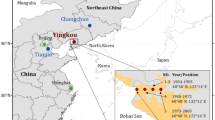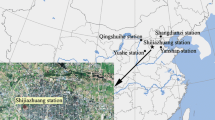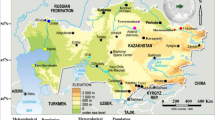Abstract
The century-long search for the precise mechanisms responsible for urban heat islands continues, while urban warming worsens in many megacities. Most studies have focused on mean temperature, daily and annual temperature ranges and urban heat island intensity. We hypothesize that an analysis of the changes in the characteristics of the complete daily and annual temperature cycles, including not only the mean temperature and temperature ranges (amplitudes) but also the maximum and minimum temperatures and the phases, can provide more information on urban warming phenomena. Through a detailed analysis of long-term observations in Hong Kong, we found that the difference in the daily cycle between urban and rural stations is very distinct, whereas the annual cycles are much more similar, suggesting that the urban environment has a greater effect on the daily cycle than on the annual cycle. The daily phase has shifted a total of 1.77 h later over the last 130 years (1.36 h per century) in the urban area of Hong Kong according to the Hong Kong Observatory (HKO) data. The annual phase change at HKO reflects the globally observed phenomenon that the annual phase advances or seasons onset earlier.








Similar content being viewed by others
References
Arnfield AJ (2003) Two decades of urban climate research: a review of turbulence, exchanges of energy and water, and the urban heat island International. J Climatol 23:1–26
Balling RC Jr, Michaels PJ, Knappenberger PC (1998) Analysis of winter and summer warming rates in gridded temperature time series. Clim Res 9:175–181
Buchan GD (2001) Soil temperature regime. In: Smith KA, Mullins C (eds) Soil and environmental analysis: physical methods, 2nd edn. New York, Marcel Dekker, pp 539–594
Cao C, Lee X, Liu S, Schultz N, Xiao W, Zhang M, Zhao L (2016) Urban heat islands in China enhanced by haze pollution. Nat Commun 7:12509. doi:10.1038/ncomms12509
Carnahan WH, Larson RC (1990) An analysis of an urban heat sink. Remote Sens Environ 33:65–71
Cassou C, Cattiaux J (2016) Disruption of the European climate seasonal clock in a warming world. Nat Clim Change 6:589–594
Cayan DR, Dettinger MD, Kammerdiener SA, Caprio JM, Peterson DH (2001) Changes in the onset of spring in the western United States. Bull Am Meteorol Soc 82:399–415
Chan H, Kok M, Lee T (2012) Temperature trends in Hong Kong from a seasonal perspective. Clim Res 55:53–63
Cornes RC, Jones P, Qian C (2017) Twentieth-century trends in the annual cycle of temperature across the northern hemisphere. J Clim. doi:10.1175/JCLI-D-16-0315.1
Duren RM, Miller CE (2012) Measuring the carbon emissions of megacities. Nat Clim Change 2:560–562
Easterling DR et al (1997) Maximum and minimum temperature trends. for the globe Science 277:364–367
Gallo KP, Easterling DR, Peterson TC (1996) The influence of land use/land cover on climatological values of the diurnal temperature range. J Clim 9:2941–2944
Giannaros TM, Melas D, Daglis IA, Keramitsoglou I, Kourtidis K (2013) Numerical study of the urban heat island over Athens (Greece) with the WRF model. Atmos Environ 73:103–111
IPCC (2013) Climate Change 2013: The Physical Science Basis. Contribution of Working Group I to the Fifth Assessment Report of the Intergovernmental Panel on Climate Change. Cambridge University Press, Cambridge. doi:10.1017/CBO9781107415324
Jones PD, Groisman PY, Coughlan M, Plummer N, Wang WC, Karl TR (1990) Assessment of urbanization effects in time series of surface air temperature over land. Nature 347:169–172
Kuo HL (1968) The thermal interaction between the atmosphere and the earth and propagation of diurnal temperature waves. J Atmos Sci 25:682–717
Li L, Chan PW, Wang D, Tan M (2015) Rapid urbanization effect on local climate: intercomparison of climate trends in Shenzhen and Hong Kong, 1968–2013. Clim Res 63:145–155
Luterbacher J, Dietrich D, Xoplaki E, Grosjean M, Wanner H (2004) European seasonal and annual temperature variability, trends, and extremes since 1500. Science 303:1499–1503
McCarthy MP, Best MJ, Betts RA (2010) Climate change in cities due to global warming and urban effects. Geophys Res Lett 37:L09705. doi:10.1029/2010GL042845
McKinnon KA, Stine AR, Huybers P (2013) The spatial structure of the annual cycle in surface temperature: Amplitude, phase, and Lagrangian history. J Clim 26:7852–7862
Mitchell JM (1976) An overview of climatic variability and its causal mechanisms. Quatern Res 6:481–493
Oke TR (1987) Boundary layer climates, 2nd edn. Routledge, Abingdon
Prescott JA, Collins JA (1951) The lag of temperature behind solar radiation. Q J R Meteorol Soc 77:121–126
Qian C (2016) Disentangling the urbanization effect, multi-decadal variability, and secular trend in temperature in eastern China during 1909–2010. Atmos Sci Lett 17:177–182
Qian C, Zhang X (2015) Human influences on changes in the temperature seasonality in mid-to high-latitude land areas. J Clim 28:5908–5921
Qian C, Fu C, Wu Z (2011) Changes in the amplitude of the temperature annual cycle in China and their implication for climate change research. J Clim 24:5292–302
Siu LW, Hart MA (2013) Quantifying urban heat island intensity in Hong Kong SAR. China Environ Monit Assess 185:4383–4398
Stine AR, Huybers P (2012) Changes in the seasonal cycle of temperature and atmospheric circulation. J Clim 25:7362–7380
Stine AR, Huybers P, Fung IY (2009) Changes in the phase of the annual cycle of surface temperature. Nature 457:435–440
Thorne P et al (2016a) Reassessing changes in diurnal temperature range: intercomparison and evaluation of existing global data set estimates. J Geophys Res Atmos 121:5138–5158
Thorne P et al (2016b) Reassessing changes in diurnal temperature range: a new data set and characterization of data biases. J Geophys Res Atmos 121:5115–5137
Vinnikov KY, Robock A, Basist A (2002) Diurnal and seasonal cycles of trends of surface air temperature. J Geophys Res Atmos 107(D22):4641. doi:10.1029/2001JD002007
Wang G, Dillon ME (2014) Recent geographic convergence in diurnal and annual temperature cycling flattens global thermal profiles. Nat Clim Change 4:988–992
Wang K, Ye H, Chen F, Xiong Y, Wang C (2012) Urbanization effect on the diurnal temperature range: different roles under solar dimming and brightening. J Clim 25:1022–1027
Wang K, Li Y, Wang Y, Yang X (2017) On the asymmetry of the urban daily air temperature cycle. J Geophys Res Atmos. doi:10.1002/2017JD026589
Wild M (2009) Global dimming and brightening: a review. J Geophys Res Atmos 114:D00D16. doi:10.1029/2008JD011470
Wong MC, Mok HY, Lee TC (2011) Observed changes in extreme weather indices in Hong Kong. Int J Climatol 31:2300–2311
Wu Z, Huang NE, Long SR, Peng CK (2007) On the trend, detrending, and variability of nonlinear and nonstationary time series. Proc Natl Acad Sci 104:14889–14894
Yang X, Li Y, Luo Z, Chan PW (2017) The urban cool island phenomenon in a high-rise high-density city and its mechanisms. Int J Climatol 37:890–904
Acknowledgements
This work was funded by a RGC CRF project (HKU9/CRF/12G) of the Government of the Hong Kong SAR, China and a grant awarded by the Key Laboratory of Eco Planning and Green Building, Tsinghua University, MOE, China. We thank two anonymous reviewers for their valuable comments and suggestions. We would also like to thank Mr. Shun Chi-ming, Director of Hong Kong Observatory, and Dr. LEE Tsz-cheung for their help.
Author information
Authors and Affiliations
Corresponding author
Rights and permissions
About this article
Cite this article
Wang, K., Li, Y., Luo, Z. et al. Harmonic analysis of 130-year hourly air temperature in Hong Kong: detecting urban warming from the perspective of annual and daily cycles. Clim Dyn 51, 613–625 (2018). https://doi.org/10.1007/s00382-017-3944-y
Received:
Accepted:
Published:
Issue Date:
DOI: https://doi.org/10.1007/s00382-017-3944-y




